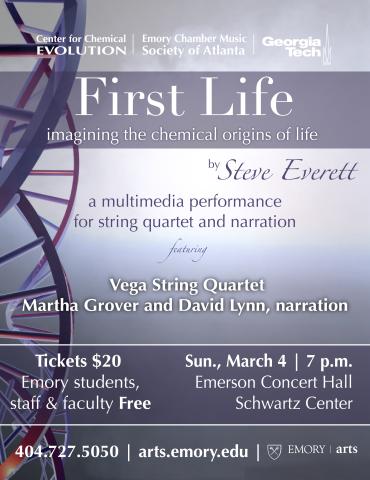event
First Life – A Multimedia Performance for String Quartet and Narration
Primary tabs
On Sunday, March 4 at 7:00 p.m. the Schwartz Center for Performing Arts at Emory University will offer a rare treat to its patrons called First Life, which combines music and science in a unique multimedia performance.
First Life blends string quartet, narration, live audio processing, surround sound diffusion, live motion capture video projection, and audience participation. Supported by the Center for Chemical Evolution, the composition of the work draws upon stochastic modeling of chemical data provided by Martha Grover’s research group in the School of Chemical & Biomolecular Engineering.
Funded by the National Science Foundation and the NASA Astrobiology Program, the Center for Chemical Evolution is an interdisciplinary research collaboration focused on exploring chemical processes that enable the spontaneous formation of functional polymers — such as proteins and DNA — from much smaller and simpler starting materials.
The inspiration for the First Life performance and the scientific basis that supports the composition stems directly from research conducted as part of the Center for Chemical Evolution. Each section of the work is constructed from contingent outcomes drawn from Grover’s biochemical research exploring the early Earth formations of organic compounds.
“A biological organism has the ability to respond to its environment and learn from its past experiences, while human-designed systems are typically more rigid and thus less ‘intelligent’,” Grover wrote in 2011 in Design of An Intelligent Material.
Composer and conductor Steve Everett, an Emory University professor of music, director of the Center for Faculty Development and Excellence, and assistant vice provost for academic affairs, credits this conclusion from Grover’s work as important when forming his initial conception of the composition.
The work also utilizes the results from the 1953 Miller-Urey experiments, which demonstrated that organic compounds such as amino acids, essential to cellular life, could be made easily under the conditions that scientists suspected to be present on the early Earth.
“This interactive composition attempts to model a biological organism’s ability to respond to the conditions of its environment by the use of real time computer programming systems generating live audio and video,” says Everett. “This project attempts to create auditory models, or sonifications, of many of the elemental and environmental conditions present in early Earth, thus providing a new way to imagine the salient biochemical morphologies at play in the origins of evolution.”
Grover and David Lynn, department chair of chemistry and professor of biomolecular chemistry at Emory University, will speak about aspects of their research in the Center for Chemical Evolution during the Interludes sections of the First Life performance.
The event is free for all students from any school or university and free for everyone who mentions the Atlanta Science Tavern at the box office.
This project was supported by the National Science Foundation (NSF) (Award No. CHE-1004570) and the NASA Astrobiology Program. The content is solely the responsibility of the principal investigators and does not necessarily represent the official views of the NSF or NASA.
Status
- Workflow status: Published
- Created by: Josie Giles
- Created: 02/23/2012
- Modified By: Fletcher Moore
- Modified: 10/07/2016
Categories


